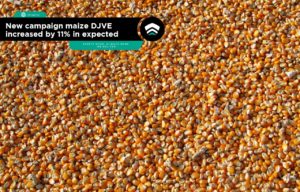New campaign maize DJVE increased by 11% in expected exports due to production cuts
The export permits for the next maize campaign reach 67% of the export forecasts and 90% of the authorized quota, while those of the SB complex predict higher proportional sales of by-products.
In recent weeks, the climate situation in South America largely marked the direction of the global market for agricultural commodities. At first, agents’ concerns about possible production cuts supported prices, while later, harvest estimates from numerous South American institutions and organizations confirmed expectations with significant declines. Argentina, being one of the main players in the international trade of coarse grains, had cuts close to 10% in SB production estimates that went from 45 Mil MT to 40.5 Mil MT (-4.5 Mil MT). In maize, the revision was almost 14%, going from 56 Mil MT to 48 Mil MT (-8 Mil MT).
The reduced maize harvest will limit Argentina’s export performance in the 2021/22 business cycle. In recent weeks, the Sworn Declarations of External Sales (DJVE) of corn for the next campaign (2021/22) barely increased in volume. Despite this, there is an accumulated tonnage of 22.4 Mil MT up to February 16, implying a historical record in absolute terms and representing 67% of the preliminary export estimates for the said cycle (33.5 Mil MT). It is worth clarifying that climate conditions caused a considerable cut in the exportable balance of the next harvest, precisely increasing the participation of the DJVE over exports. At the same time, the quotas and “balance volumes” that have been imposed for this next campaign by the Government must be taken into account. Therefore, the export outlook is even more restricted since with the 25 Mil MT enabled so far for the 2021/22 cycle, only 2.56 Mil MT would remain to declare for exports.
The SB market, for its part, shows a very different evolution from that of maize, since the DJVE registered to date represents a smaller proportion compared to the historical exports of the sector. It should be noted that exports of SB by-products 2021/22 have been declared for a volume greater than 1.5 Mil MT, exceeding the records achieved a year ago, but far from the 4.9 Mil MT that had been declared before the start of the 2019/20 crop.

A conclusion we can come to from the data available today is that a lower proportion of bean exports and greater participation of by-products can be expected. Likewise, the outlook that is presented for the Argentine oilseed industry must be taken into account, which will have an estimated production of 40.5 Mil MT. Meanwhile, Paraguay -the main foreign supplier of SB for Argentina- was not immune to the pressing climate situation in South America, and its production is expected to total just 4 Mil MT in 2021/22, according to data from CAPECO (Paraguayan Chamber of Exporters and Traders of Cereals and Oilseeds). We can better grasp the dimension of this drop in production is when we see that during the last 5 campaigns the Paraguayan SB harvest has never been below 8.5 Mil MT. Under these conditions, the Argentine oilseed industry, which has a crush capacity of 69 Mil MT per year, will face a tighter SB supply and it is expected that the level of crush will be below the average of the last 5 seasons, 40 Mil MT.
Coarse grains: where do funds stand in Chicago?
On the international plane, there is evidence of a market where agents, even before the cuts in South American estimates, already discounted the possibility of adverse news for grain production. Analyzing the evolution of the positioning of investment funds in recent years, a clear upward bias is observed. On January 18, there were purchases of SB futures equivalent to 13.6 Mil MT and in the following weeks, the purchase only strengthened, reaching 22.6 Mil MT on February 8, and facing maximum records since May 2021. In other words, in two weeks the volume of the funds’ purchased position was increased by 9 Mil MT. This coincides with a 15% increase in the values of SB futures traded in Chicago, since in mid-January the contract with the highest traded volume reached 500 USD/MT, while the same 3 weeks later had a price of 576 USD/MT. Furthermore, despite having shown profit-taking sessions and where the forecasts of rain for Argentina and Brazil negatively pressured SB subproducts, the price of the SB contract ended up climbing to 585 USD/MT in the afternoon of Thursday.
As for the maize market, it showed a development similar to that of SB since the positioning of investment funds supported the growth in the futures values. However, for cereal, the bullish influence was seen from the beginning of September 2021 when the equivalent of 27 Mil MT of futures were traded, to end on February 8 with 42.8 Mil MT. In this same period, the price of maize futures with the largest volume traded in Chicago went from 201 to 248 USD/MT, increasing by 23.8%. Additionally, the reference market for maize closed yesterday’s round with a level of 256 MT/MT for the future with delivery in March, assuming an even higher rise. On the other hand, the Russian-Ukrainian conflict has notably collaborated in the increase in cereal prices, since the second of these countries plays a key role in supplying the international maize market. In conclusion, based on the positioning analysis of the US investment funds, it can be affirmed that the coarse grain markets have a strong bullish conviction among their agents, while the South American drought and the tension in the Black Sea Region support the prices of these commodities.
Source: https://bcr.com.ar/
Photo: REUTERS/Stringer
For more info visit
https://www.linkedin.com/company/wbl-shipping-agency/
